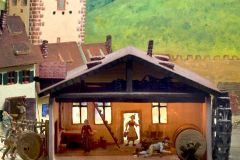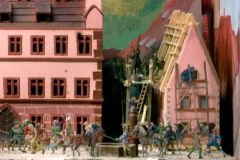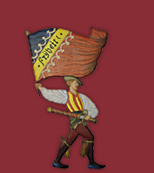
Showcases referring to social history
The gem-cutting and polishing workshops of Freiburg (Diorama 13)

The first reference to a grinding mill located at the Gerberau-channel occurs in 1368. The nearness of the Black Forest with its raw materials (e.g. minerals and water power) fostered the development of a gem-cutting industry in Freiburg. The polishers (Balierer) trimmed the gems (rock-crystals, garnets, agates) into a rounded shape by grinding them at the heavy grindstones. The grinded gems were handed to the “Bohrer” who pierced them with a drill. Then the excavation was carried out by the “Hohlwerker”, craftsmen skilled to grind the vessels at the inside. Finally the goldsmiths framed the crystal-bowls with a golden or silver setting.
During the 16th and 17th century Freiburg's gem-cutting industry was most prosperous. At that time, exclusively the members of the gem-cutting guild were allowed to import the rock-crystals from central Switzerland (Gotthard and Grimsel region) and also to sell them. Thanks to a privilege of 1601 by emperor Rudolf II., Freiburg acquired the exceptional status to be the only place to manufacture the garnets from Bohemia within the Austrian Empire! In 1625 almost 200 Bohr&Balier-chief operators are registered in Freiburg.
When the 30 Years War reached Freiburg in 1632, the gem-cutting industry sank down immediately. During the French occupation 1677-1698 it ceased to exist.
The years after 1750 brought a short term revival when empress Maria Theresia promoted Freiburg's gem-cutting industry in order to foster the export of luxury goods – according to the economic goals of mercantilism. When her renewal of Rudolf's II. garnet-manufacturing privilege was suspended already in 1775 it initiated the final decline of Freiburg's famous gem-cutting industry. In 1808 only 12 remaining grinding mills are registered in the Breisgau region.
The prosecution of witches: An execution of the widows of three magistrates, Freiburg 1599 (Diorama 16)
After having passed the sentence to be witches, Margarethe Mößmerin, Anna Wolffahrtin und Catharina Stadelmannin, all of them widows of former magistrates of Freiburg´s city council, run the gauntlet along the main road through the Martinstor to the execution stake at the Basle country road, were they are decapitated on 24. 3. 1599.
 During the 14th century the inquisiton, which had been initiated to suppress heredicts, was commissioned with the prosecution of witchcraft and magic, both said to be inspired by the devil. The volume “Malleus Maleficarum” (“Hexenhammer”), published in 1487 by the two theologians Heinrich Institoris und Jakob Sprenger lecturing at the university of Freiburg, became the guideline for the trial of witches. The accusations were always similar: witchcraft, contract with the devil, renunciation of god, the “Sabbath of witches” (a get together of “fiancées” in the night followed by a ride through the air on the back of animals). The magistrate was in charge of the trial and the chairman of the city council had to conduct the interrogation. The end of the 16th century in Freiburg saw a culmination into a widespread prosecution of witches with numerous innocent victims (12 women in 1599, 13 women in 1603). This is regarded as a manifestation of the public´s obsessive fears in that time, caused by starvation and the plague.
During the 14th century the inquisiton, which had been initiated to suppress heredicts, was commissioned with the prosecution of witchcraft and magic, both said to be inspired by the devil. The volume “Malleus Maleficarum” (“Hexenhammer”), published in 1487 by the two theologians Heinrich Institoris und Jakob Sprenger lecturing at the university of Freiburg, became the guideline for the trial of witches. The accusations were always similar: witchcraft, contract with the devil, renunciation of god, the “Sabbath of witches” (a get together of “fiancées” in the night followed by a ride through the air on the back of animals). The magistrate was in charge of the trial and the chairman of the city council had to conduct the interrogation. The end of the 16th century in Freiburg saw a culmination into a widespread prosecution of witches with numerous innocent victims (12 women in 1599, 13 women in 1603). This is regarded as a manifestation of the public´s obsessive fears in that time, caused by starvation and the plague.


